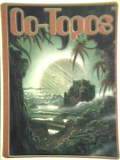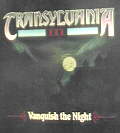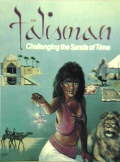The Comprehend Adventures
By 1984 the personal computer scene was jumbled, to say the least. The Apple II was getting old and being replaced by new technologies. Some extensions to the Apple II line gave nice new abilities within the limits of an 8-bit machine. An example was the increase to "double hi-res" graphics: there were now 16 colors available instead of the original 6! But Macintosh was clearly the computer of Apple's future, and through the 80's Mac technology meant black-and-white.
The IBM Personal Computer was dominant in business applications, but IBM tanked in its first foray into the home market with the PC Junior. The original PC had worse graphics than the Apple II: only four colors were available at any given time. New graphics adapters were released by several companies, but there were conflicting graphics standards among them.
Meanwhile Commodore was replacing its outdated (but huge-selling) Commodore 64 with the Amiga, and Atari was replacing its original 8-bit machines with the 16-bit ST series. Both these new computers easily had the best multimedia capabilities of the day, but the question was whether they would sell enough to create a sustained market for software. Earlier machines from both these companies were huge mass-market successes. Would they repeat?
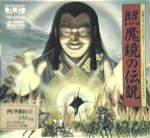
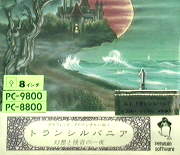 Then there was the question of whether one or more of the big Japanese
manufacturers would jump into the U.S. market with their computers, different again
entirely. We were already licensing several of our titles in Japan for NEC and Fujitsu
computers. At left is the Japanese cover for The Coveted Mirror, and at right is
part of the Japanese Transylvania cover. They tested the waters here but
eventually it was a game machine, the Nintendo, that made the big splash in the U.S.
Then there was the question of whether one or more of the big Japanese
manufacturers would jump into the U.S. market with their computers, different again
entirely. We were already licensing several of our titles in Japan for NEC and Fujitsu
computers. At left is the Japanese cover for The Coveted Mirror, and at right is
part of the Japanese Transylvania cover. They tested the waters here but
eventually it was a game machine, the Nintendo, that made the big splash in the U.S.
Altogether, it made things rather uncertain for a company whose bread-and-butter was computer graphics software that was necessarily very machine-specific. With 20/20 hindsight it's easy to see what the most lucrative path would have been, but we needed to hedge our bets. We chose a direction that would develop new technologies that were not platform-dependent.
The Plan
Our graphics adventure games had done well. We'd published four: Transylvania, The Coveted Mirror, Quest, and Ring Quest. As we converted Transylvania to other platforms (Atari, Commodore, IBM, Macintosh) we developed the Graphics Magician picture technology to allow the images themselves to work on various machines without having to be redrawn by hand.
We also knew that text adventures, primarily those by Infocom, were very well-respected because of the writing and their language capability. Most adventure games (including ours) used two-word verb/noun commands, such as "Go North", "Take book", "Read book". Infocom's adventures used a full-sentence parser, so players could use commands like "Walk to the north, pick up the book and read it."
Our goal became to write our own adventure programming language that would let us create entire adventure games, including graphics, and save them as completely system-independent data files. Interpreters for this adventure language would be written for whatever computer we chose. We'd be able to release new adventure titles for six or seven different computers at a time. Overall development time would be reduced (mostly the time involved in conversions to other computers), and marketing would be simplified. And the adventures would have state-of-the-art full-sentence parsing combined with the graphics for which we were known. The new language and interpreter would be called Comprehend.
Comprehend
The Comprehend language, compiler, and interpreter were designed and programmed in-house by Mark Pelczarski and Jeffrey Jay. Robert Hardy, Peter Schmitt, Eagle Berns, and Jeff Tunnell's group at dynamix converted the interpreters for Comprehend and The Graphics Magician to other computers. Antonio Antiochia revised most of his original graphics, and provided new scenes and new adventures. Raimund Redlich and Brian Poff added their wonderful graphics from Pittsburgh, PA. And at Penguin Software, Ron Schmitt, Mary Beth Miller, Bruce Hoffman, Lisa Smith, and Kathy Pelczarski all became part of the programming crew, writing and refining adventures in the new Comprehend language.
The first "Comprehend Interactive Novels" were released in the Fall of 1985. Antonio's sequel to Transylvania, The Crimson Crown, was the first adventure written totally in Comprehend. Transylvania was also re-released in a new Comprehend edition, with newer graphics and more puzzles and locations than the original. The Comprehend release of Transylvania was also its first appearance for computers such as the Atari ST and the Commodore Amiga.
The third Comprehend release, the science-fiction adventure Oo-Topos was originally a text adventure by Mike Berlyn, published by Sentient Software before Mike's days as one of the premier authors at Infocom. We met Mike while he was in Colorado with Sentient, and he was writing games using The Graphics Magician. We maintained a friendship, and when we decided to move forward with Comprehend, he agreed to let us "modernize" his Oo-Topos story, using our new technology. It became one of the better Comprehend games.
 Oo-Topos: Comprehend, DSK archive, Apple
16-color graphics
Oo-Topos: Comprehend, DSK archive, Apple
16-color graphics
|
 Oo-Topos: Comprehend, PC format, 4-color CGA
graphics
Oo-Topos: Comprehend, PC format, 4-color CGA
graphics
|
 Oo-Topos hint booklet
Oo-Topos hint booklet
|
The next year we released a new Comprehend edition of The Coveted Mirror. The original was one of our favorites, but it had only been released for the Apple II. We actually had to remove a couple short action games from the original (one was the "jousting tournament") to get it to fit within the new language (and to avoid the old conversion hassles), but a few new puzzles were added along with the new parser.
 The Coveted Mirror: Comprehend edition
in DSK archive, Apple 16-color graphics
The Coveted Mirror: Comprehend edition
in DSK archive, Apple 16-color graphics
|
 The Coveted Mirror hint booklet
The Coveted Mirror hint booklet
|
Bruce Hoffman wrote an original game, Talisman, which would be the last Comprehend adventure published by our company. Only one more Comprehend adventure was released later by the new owners: Antonio Antiochia's Transylvania III.
 Talisman: Comprehend in DSK archive, Apple 16-color graphics
Talisman: Comprehend in DSK archive, Apple 16-color graphics
|
 Talisman: Comprehend, PC format, 4-color CGA graphics
Talisman: Comprehend, PC format, 4-color CGA graphics
|
 Talisman hint booklet
Talisman hint booklet
|
 Transylvania III: Comprehend, PC format
Transylvania III: Comprehend, PC formatarchive contributed by Stephane Pellegrino |

Two Comprehend adventures were on the drawing boards, all storyboarded and ready to begin programming, but never made it: Jimmy Buffett's Margaritaville Adventure (WAAAY back when "Margaritaville" was just a song and many years before it turned into an empire!), and an adventure based on the comic strip characters Frank and Ernest.
 One of our local friends, Dav Holle, was friends with some of the people
who worked on the Frank and Ernest strip. Dav himself wrote and published Zoom
Grafix and an adventure game, Sherwood Forest, through another local
company, Phoenix Software. Dav also did some programming work for us, especially helping
out with disk duplication software. His doodles of flightless Antarctic birds (sometimes
on envelopes or napkins) occasionally found their way into print here and there.
One of our local friends, Dav Holle, was friends with some of the people
who worked on the Frank and Ernest strip. Dav himself wrote and published Zoom
Grafix and an adventure game, Sherwood Forest, through another local
company, Phoenix Software. Dav also did some programming work for us, especially helping
out with disk duplication software. His doodles of flightless Antarctic birds (sometimes
on envelopes or napkins) occasionally found their way into print here and there.
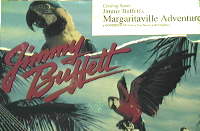 Indirectly through Mike Berlyn, Mark got in touch with Jimmy Buffett, who
lived in the same general area of Colorado as Mike for a while. Buffett was planning a
Margaritaville movie and thought a Margaritaville adventure game sounded
cool. A separate story was loosely written around the locale and some of the characters
from the movie script. But alas, Jimmy's folks tied the fate of the software to the movie
(they probably didn't want a prior software deal affecting later financing for the movie),
and the financing for the movie then fell through anyway. By the time that happened, the
company had changed hands. However, Mark did publish some MIDI music software under the new
"Magic Tree" name (and used the software in a steel band in which he played, Stainless
Steel). And through this earlier acquaintance with Buffett, Mark wound up setting up the
computerized part of Jimmy's Shrimpboat Sound recording studio in Key West and worked on a
couple albums there. (Check out the liner notes of Buffett's Hot Water. More than a few
friends were jokingly mystified by the last spoken words at the end of that CD: "Thank you, Mark"!)
Jimmy shared a management agency with Dan Fogelberg, and through that and other professional
acquaintances Mark wound up in Colorado setting up his studio, too.
Indirectly through Mike Berlyn, Mark got in touch with Jimmy Buffett, who
lived in the same general area of Colorado as Mike for a while. Buffett was planning a
Margaritaville movie and thought a Margaritaville adventure game sounded
cool. A separate story was loosely written around the locale and some of the characters
from the movie script. But alas, Jimmy's folks tied the fate of the software to the movie
(they probably didn't want a prior software deal affecting later financing for the movie),
and the financing for the movie then fell through anyway. By the time that happened, the
company had changed hands. However, Mark did publish some MIDI music software under the new
"Magic Tree" name (and used the software in a steel band in which he played, Stainless
Steel). And through this earlier acquaintance with Buffett, Mark wound up setting up the
computerized part of Jimmy's Shrimpboat Sound recording studio in Key West and worked on a
couple albums there. (Check out the liner notes of Buffett's Hot Water. More than a few
friends were jokingly mystified by the last spoken words at the end of that CD: "Thank you, Mark"!)
Jimmy shared a management agency with Dan Fogelberg, and through that and other professional
acquaintances Mark wound up in Colorado setting up his studio, too.
Many years later, the Jimmy Buffett connection re-surfaced, and Mark wound up playing steel drums on stage with Jimmy for several charity events. Here's a video from one of them.





